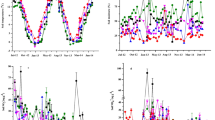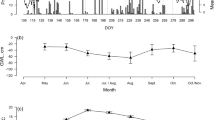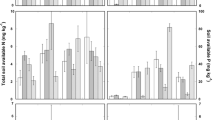Abstract
The relevance of soil greenhouse gas (GHG) fluxes from temperate floodplain forests has yet remained elusive. We studied the soil methane (CH4), nitrous oxide (N2O) and carbon dioxide (CO2) dynamics at three forest sites along a flooding gradient in the Danube National Park (Austria) to estimate annual GHG budgets and to assess if and how seasonal flooding affects individual GHG fluxes. Soil surface GHG fluxes were determined along with GHG concentrations in soil air and pore-water at a non-flooded (NF), an infrequently-flooded (IF), and a frequently-flooded (FF) site. Both study years were characterized by dry summers, and only the FF site was flooded during the study period. Soils at all sites were annual CH4 sinks (NF: − 4.50 ± 0.85, IF: − 2.54 ± 0.57, FF: − 0.67 ± 1.06 kg CH4-C ha−1 year−1) and the sink strength correlated positively with soil moisture. Pulse-like CH4 emissions were not observed during or after flooding. Soil N2O fluxes showed large temporal and spatial variations, without any significant differences between sites (average NF: 6.5 ± 7.1, IF: 10.4 ± 14.3, FF: 9.4 ± 10.5 µg N2O-N m−2 h−1). Pulse N2O emissions (up to ~ 80 µg N2O-N m−2 h−1) occurred during freeze/thaw events, but not during or after flooding. Mean annual soil CO2 effluxes at NF and IF were 9.4 ± 1.1 and 9.4 ± 2.1 t C ha−1 year−1, respectively. Soil CO2 efflux was significantly higher at the FF site (18.54 ± 6.21 t C ha−1 year−1). High soil air CO2 concentrations (> 10%) in aerated deeper soil layers indicated a substantial contribution of the usually waterlogged sub-soils to the summertime soil CO2 efflux at the FF site. Overall, our results suggest that the studied temperate floodplain forest soils do not absorb/emit substantially more CH4 and N2O than soils of comparable upland forests, whereas low groundwater level can lead to periodically enhanced CO2 emissions from normally waterlogged soil layers.






Similar content being viewed by others
Data availability
Data and other relevant materials are readily available on request.
Code availability
R programming code used for statistical analysis is available on request.
References
Acosta M, Darenova E, Dušek J, Pavelka M (2017) Soil carbon dioxide fluxes in a mixed floodplain forest in the Czech Republic. Eur J Soil Biol 82:35–42
Barbati A, Corona P, Marchetti M (2011) Annex 1: pilot application of the european forest types. In: FOREST EUROPE, UNECE and FAO 2011. State of Europe’s Forests 2011. Status and Trends in Sustainable Forest Management in Europe
Bartlett KB, Crill PM, Bonassi JA et al (1990) Methane flux from the Amazon River floodplain: emissions during rising water. J Geophys Res 95:16773–16788. https://doi.org/10.1029/JD095iD10p16773
Batlle-Aguilar J, Brovelli A, Luster J et al (2012) Analysis of carbon and nitrogen dynamics in riparian soils: Model validation and sensitivity to environmental controls. Sci Total Environ 429:246–256. https://doi.org/10.1016/j.scitotenv.2012.04.026
Batson J, Noe GB, Hupp CR et al (2015) Soil greenhouse gas emissions and carbon budgeting in a short-hydroperiod floodplain wetland. J Geophys Res Biogeosci 120:77–95. https://doi.org/10.1002/2014JG002817
Bodelier PLE, Bär-Gilissen M-J, Meima-Franke M, Hordijk K (2011) Structural and functional response of methane-consuming microbial communities to different flooding regimes in riparian soils. Ecol Evol 2:106–127. https://doi.org/10.1002/ece3.34
Boon PI, Mitchell A, Lee K (1997) Effects of wetting and drying on methane emissions from ephemeral floodplain wetlands in south-eastern Australia. Hydrobiologia 357:73–87. https://doi.org/10.1023/A:1003126601466
Born M, Dörr H, Levin I (1990) Methane consumption in aerated soils of the temperate zone. Tellus B 42:2–8. https://doi.org/10.1034/j.1600-0889.1990.00002.x
Bowden RD, Rullo G, Stevens GR, Steudler PA (2000) Soil fluxes of carbon dioxide, nitrous oxide, and methane at a productive temperate deciduous forest. J Environ Qual 29:268–276. https://doi.org/10.2134/jeq2000.00472425002900010034x
Burgin AJ, Groffman PM (2012) Soil O2 controls denitrification rates and N2O yield in a riparian wetland. J Geophys Res Biogeosci 117:G01010. https://doi.org/10.1029/2011jg001799
Christiansen JR, Vesterdal L, Gundersen P (2012) Nitrous oxide and methane exchange in two small temperate forest catchments: effects of hydrological gradients and implications for global warming potentials of forest soils. Biogeochemistry 107:437–454. https://doi.org/10.1007/s10533-010-9563-x
Cools N, De Vos B (2016) Part X: sampling and Analysis of Soil. In: UNECE ICP Forests Programme Co-ordinating Centre (ed.): Manual on methods and criteria for harmonized sampling, assessment, monitoring and analysis of the effects of air pollution on forests. Thünen Institute of Forest Ecosystems, Eberswalde, Germany, p 29 p + Annex
De Carlo N, Oelbermann M, Gordon A (2019) Spatial and temporal variation in soil nitrous oxide emissions from a rehabilitated and undisturbed riparian forest. J Environ Qual 48:624–633
Ding W, Cai Z, Tsuruta H (2004) Methane concentration and emission as affected by methane transport capacity of plants in freshwater marsh. Water Air Soil Pollut 158:99–111. https://doi.org/10.1023/B:WATE.0000044836.71634.3d
dos Santos M, Pinto R, Weigelhofer G, Diaz-Pines E et al (2020) River-floodplain restoration and hydrological effects on GHG emissions: Biogeochemical dynamics in the parafluvial zone. Sci Total Environ 715:136980. https://doi.org/10.1016/j.scitotenv.2020.136980
Dybala KE, Matzek V, Gardali T, Seavy NE (2019) Carbon sequestration in riparian forests: a global synthesis and meta-analysis. Glob Change Biol 25:57–67. https://doi.org/10.1111/gcb.14475
Epron D, Farque L, Lucot E, Badot PM (1999) Soil CO2 efflux in a beech forest: the contribution of root respiration. Ann for Sci 56:289–295
Fan S, Yoh M (2020) Nitrous oxide emissions in proportion to nitrification in moist temperate forests. Biogeochemistry 148:223–236. https://doi.org/10.1007/s10533-020-00655-w
FAO (1998) World Reference Base for Soil Resources. Food and Agriculture Organization of the United Nations, Rome
Fender A-C, Gansert D, Jungkunst HF et al (2013) Root-induced tree species effects on the source/sink strength for greenhouse gases (CH4, N2O and CO2) of a temperate deciduous forest soil. Soil Biol Biochem 57:587–597. https://doi.org/10.1016/j.soilbio.2012.08.004
Figueiredo V, Pangala S, Paecock M, et al (2019) Contribution of trees to the N2O budget of Amazon floodplain forest. In: Geophysical Research Abstracts (21). pp EGU2019–18212
Formánek P, Ambus P (2004) Assessing the use of δ13C natural abundance in separation of root and microbial respiration in a Danish beech (Fagus sylvatica L.) forest. Rapid Commun Mass Spectrom 18:897–902. https://doi.org/10.1002/rcm.1424
Forshay K, Stanley E (2005) Rapid nitrate loss and denitrification in a temperate river floodplain. Biogeochemistry 75:43–64. https://doi.org/10.1007/s10533-004-6016-4
Gatica G, Fernández ME, Juliarena MP, Gyenge J (2020) Environmental and anthropogenic drivers of soil methane fluxes in forests: global patterns and among-biomes differences. Glob Change Biol 26:6604–6615. https://doi.org/10.1111/gcb.15331
Gower ST, McMurtrie RE, Murty D (1996) Aboveground net primary production decline with stand age: potential causes. Trends Ecol Evol 11:378–382. https://doi.org/10.1016/0169-5347(96)10042-2
Gundersen P, Schmidt IK, Raulund-Rasmussen K (2006) Leaching of nitrate from temperate forests effects of air pollution and forest management. Environ Rev 14:1–57
Hefting M, Clément JC, Dowrick D et al (2004) Water table elevation controls on soil nitrogen cycling in riparian wetlands along a European climatic gradient. Biogeochemistry 67:113–134. https://doi.org/10.1023/b:biog.0000015320.69868.33
Hefting MM, Bobbink R, Janssens MP (2006) Spatial variation in denitrification and N2O emission in relation to nitrate removal efficiency in a N-stressed Riparian Buffer Zone. Ecosystems 9:550–563. https://doi.org/10.1007/s10021-006-0160-8
Hein T, Schwarz U, Habersack H et al (2016) Current status and restoration options for floodplains along the Danube River. Sci Total Environ 543:778–790. https://doi.org/10.1016/j.scitotenv.2015.09.073
Huber B, Luster J, Bernasconi SM et al (2012) Nitrate leaching from short-hydroperiod floodplain soils. Biogeosciences 9:4385–4397
IPCC, 2021: Climate Change 2021: The Physical Science Basis. Contribution of Working Group I to the Sixth Assessment Report of the Intergovernmental Panel on Climate Change. In :Masson-Delmotte V, Zhai P, Pirani A, Connors SL, Péan C, Berger S, Caud N, Chen Y, Goldfarb L, Gomis MI, Huang M, Leitzell K, Lonnoy E, Matthews JBR, Maycock TK, Waterfield T, Yelekçi O, Yu R, Zhou B (eds.) Cambridge University Press. In Press
Itoh M, Ohte N, Koba K et al (2007) Hydrologic effects on methane dynamics in riparian wetlands in a temperate forest catchment. J Geophys Res Biogeosci. https://doi.org/10.1029/2006JG000240
Jacinthe PA (2015) Carbon dioxide and methane fluxes in variably-flooded riparian forests. Geoderma 241–242:41–50. https://doi.org/10.1016/j.geoderma.2014.10.013
Kassambara A (2021) Pipe-friendly framework for basic statistical tests [R Package Rstatix Version 0.7. 0]. February https://www.mranmicrosoftcom/web/packages/rstatix/indexhtml
Keeling CD (1958) The concentration and isotopic abundances of atmospheric carbon dioxide in rural areas. Geochim Cosmochim Acta 13:322–334
Kesik M, Ambus P, Baritz R et al (2005) Inventories of N2O and NO emissions from European forest soils. Biogeosciences 2:353–375. https://doi.org/10.5194/bg-2-353-2005
Kim D-G, Vargas R, Bond-Lamberty B, Turetsky MR (2012) Effects of soil rewetting and thawing on soil gas fluxes: a review of current literature and suggestions for future research. Biogeosciences 9:2459–2483. https://doi.org/10.5194/bg-9-2459-2012
Kitzler B, Zechmeister-Boltenstern S, Holtermann C et al (2006) Nitrogen oxides emission from two beech forests subjected to different nitrogen loads. Biogeosciences 3:293–310. https://doi.org/10.5194/bg-3-293-2006
Krause S, Lewandowski J, Grimm NB et al (2017) Ecohydrological interfaces as hot spots of ecosystem processes. Water Resour Res 53:6359–6376. https://doi.org/10.1002/2016WR019516
Ley M, Lehmann MF, Niklaus PA, Luster J (2018) Alteration of nitrous oxide emissions from floodplain soils by aggregate size, litter accumulation and plant–soil interactions. Biogeosciences 15:7043–7057
Macdonald JA, Fowler D, Hargreaves KJ et al (1998) Methane emission rates from a northern wetland; response to temperature, water table and transport. Atmos Environ 32:3219–3227. https://doi.org/10.1016/S1352-2310(97)00464-0
Männistö E, Korrensalo A, Alekseychik P et al (2019) Multi-year methane ebullition measurements from water and bare peat surfaces of a patterned boreal bog. Biogeosciences 16:2409–2421. https://doi.org/10.5194/bg-16-2409-2019
McClain ME, Boyer EW, Dent CL et al (2003) Biogeochemical hot spots and hot moments at the interface of terrestrial and aquatic ecosystems. Ecosystems 6:301–312. https://doi.org/10.1007/s10021-003-0161-9
Medinets S, Gasche R, Skiba U et al (2016) Cold season soil NO fluxes from a temperate forest: drivers and contribution to annual budgets. Environ Res Lett 11:114012
Megonigal JP, Conner WH, Kroeger S, Sharitz RR (1997) Aboveground production in southeastern floodplain forests: a test of the subsidy–stress hypothesis. Ecology 78:370–384. https://doi.org/10.1890/0012-9658(1997)078[0370:APISFF]2.0.CO;2
Metcalfe DB, Meir P, Aragão LEOC et al (2007) Factors controlling spatio-temporal variation in carbon dioxide efflux from surface litter, roots, and soil organic matter at four rain forest sites in the eastern Amazon. J Geophys Res Biogeosci. https://doi.org/10.1029/2007JG000443
Moldaschl E, Kitzler B, Machacova K, et al (2021) Stem CH4 and N2O fluxes of Fraxinus excelsior and Populus alba trees along a flooding gradient. Plant Soil 1–14
Mørkved PT, Dörsch P, Bakken LR (2007) The N2O product ratio of nitrification and its dependence on long-term changes in soil pH. Soil Biol Biochem 39:2048–2057. https://doi.org/10.1016/j.soilbio.2007.03.006
Mortensen J, Hauge Nielsen K, JØrgensen U (1998) Nitrate leaching during establishment of willow (Salix viminalis) on two soil types and at two fertilization levels. Biomass Bioenerg 15:457–466. https://doi.org/10.1016/S0961-9534(98)00056-7
Oishi AC, Palmroth S, Butnor JR et al (2013) Spatial and temporal variability of soil CO2 efflux in three proximate temperate forest ecosystems. Agric for Meteorol 171–172:256–269. https://doi.org/10.1016/j.agrformet.2012.12.007
Pangala SR, Hornibrook ERC, Gowing DJ, Gauci V (2015) The contribution of trees to ecosystem methane emissions in a temperate forested wetland. Glob Change Biol 21:2642–2654
Pangala SR, Moore S, Hornibrook ERC, Gauci V (2013) Trees are major conduits for methane egress from tropical forested wetlands. New Phytol 197:524–531. https://doi.org/10.1111/nph.12031
Parkin TB, Venterea RT, Hargreaves SK (2012) Calculating the detection limits of chamber-based soil greenhouse gas flux measurements. J Environ Qual 41:705–715. https://doi.org/10.2134/jeq2011.0394
Petrakis S, Seyfferth A, Kan J et al (2017) Influence of experimental extreme water pulses on greenhouse gas emissions from soils. Biogeochemistry 133:147–164. https://doi.org/10.1007/s10533-017-0320-2
Pinay G, Black VJ, Planty-Tabacchi AM et al (2000) Geomorphic control of denitrification in large river floodplain soils. Biogeochemistry 50:163–182. https://doi.org/10.1023/a:1006317004639
Pitz SL, Megonigal JP, Chang C-H, Szlavecz K (2018) Methane fluxes from tree stems and soils along a habitat gradient. Biogeochemistry 137:307–320. https://doi.org/10.1007/s10533-017-0400-3
Pugh CA, Reed DE, Desai AR, Sulman BN (2018) Wetland flux controls: how does interacting water table levels and temperature influence carbon dioxide and methane fluxes in northern Wisconsin? Biogeochemistry 137:15–25. https://doi.org/10.1007/s10533-017-0414-x
Rieger I, Kowarik I, Cierjacks A (2015) Drivers of carbon sequestration by biomass compartment of riparian forests. Ecosphere 6:art185. https://doi.org/10.1890/ES14-00330.1
Ruehr NK, Buchmann N (2010) Soil respiration fluxes in a temperate mixed forest: seasonality and temperature sensitivities differ among microbial and root–rhizosphere respiration. Tree Physiol 30:165–176. https://doi.org/10.1093/treephys/tpp106
Samaritani E, Shrestha J, Fournier B et al (2011) Heterogeneity of soil carbon pools and fluxes in a channelized and a restored floodplain section (Thur River, Switzerland). Hydrol Earth Syst Sci Discuss 8:1059–1091. https://doi.org/10.5194/hessd-8-1059-2011
Schiemer F, Baumgartner C, Tockner K (1999) Restoration of floodplain rivers: the’danube restoration project’. Regul Rivers: Res Manage 15:231–244
Schindlbacher A, Borken W, Djukic I et al (2015) Contribution of carbonate weathering to the CO2 efflux from temperate forest soils. Biogeochemistry 124:273–290. https://doi.org/10.1007/s10533-015-0097-0
Schindler T, Mander Ü, Machacova K et al (2020) Short-term flooding increases CH4 and N2O emissions from trees in a riparian forest soil-stem continuum. Sci Rep 10:1–10. https://doi.org/10.1038/s41598-020-60058-7
Schloerke B, Crowley J, Cook D, et al (2018) GGally: extension to ‘ggplot2’. R package version 1.4. 0. R Foundation for Statistical Computing
Shrestha J, Niklaus PA, Pasquale N et al (2014) Flood pulses control soil nitrogen cycling in a dynamic river floodplain. Geoderma 228–229:14–24. https://doi.org/10.1016/j.geoderma.2013.09.018
Silverthorn TK, Richardson JS (2021) Temporal and microtopographical variations in greenhouse gas fluxes from riparian forest soils along headwater streams. Biogeochemistry 155:401–412. https://doi.org/10.1007/s10533-021-00832-5
Simek M, Jisova L, Hopkins DW (2002) What is the so-called optimum pH for denitrification in soil? Soil Biol Biochem 34:1227–1234
Singer MB, Stella JC, Dufour S et al (2013) Contrasting water-uptake and growth responses to drought in co-occurring riparian tree species. Ecohydrology 6:402–412. https://doi.org/10.1002/eco.1283
Soosaar K, Mander Ü, Maddison M et al (2011) Dynamics of gaseous nitrogen and carbon fluxes in riparian alder forests. Ecol Eng 37:40–53. https://doi.org/10.1016/j.ecoleng.2010.07.025
Warner DL, Bond-Lamberty B, Jian J et al (2019) Spatial predictions and associated uncertainty of annual soil respiration at the global scale. Global Biogeochem Cycles 33:1733–1745. https://doi.org/10.1029/2019GB006264
Welch B, Gauci V, Sayer EJ (2019) Tree stem bases are sources of CH4 and N2O in a tropical forest on upland soil during the dry to wet season transition. Glob Change Biol 25:361–372. https://doi.org/10.1111/gcb.14498
Welti N, Bondar-Kunze E, Singer G et al (2012) Large-scale controls on potential respiration and denitrification in riverine floodplains. Ecol Eng 42:73–84. https://doi.org/10.1016/j.ecoleng.2012.02.005
Werth M, Kuzyakov Y (2010) 13C fractionation at the root-microorganisms-soil interface: a review and outlook for partitioning studies. Soil Biol Biochem 42:1372–1384. https://doi.org/10.1016/j.soilbio.2010.04.009
Zehetner F, Lair GJ, Gerzabek MH (2009) Rapid carbon accretion and organic matter pool stabilization in riverine floodplain soils. Global Biogeochem Cycles. https://doi.org/10.1029/2009GB003481
Zentralanstalt für Meteorologie und Geodynamik (2020) Climate Data - Annals. https://www.zamg.ac.at/cms/de/klima/klimauebersichten/jahrbuch. Accessed 20 Apr 2020
Acknowledgements
The study was funded by the Austrian Klima- und Energie Fonds (ACRP9 project FloodFlux, KR16AC0K13382). We are very grateful to the National Park authorities for their friendly cooperation and help with site selection and we thank Christian Holtermann for technical support.
Funding
The study was funded by the Austrian Klima- und Energie Fonds (ACRP9 project FloodFlux, KR16AC0K13382).
Author information
Authors and Affiliations
Corresponding author
Ethics declarations
Conflict of interest
The authors have no conflicts of interest to declare that are relevant to the content of this article.
Consent for publication
All authors consent to the submission and publication of this manuscript.
Additional information
Responsible Editor: Edith Bai.
Publisher's Note
Springer Nature remains neutral with regard to jurisdictional claims in published maps and institutional affiliations.
Supplementary Information
Below is the link to the electronic supplementary material.
Rights and permissions
About this article
Cite this article
Schindlbacher, A., Heinzle, J., Gollobich, G. et al. Soil greenhouse gas fluxes in floodplain forests of the Danube National Park: effects of flooding and soil microclimate. Biogeochemistry 159, 193–213 (2022). https://doi.org/10.1007/s10533-022-00921-z
Received:
Accepted:
Published:
Issue Date:
DOI: https://doi.org/10.1007/s10533-022-00921-z




